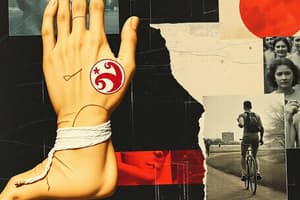Podcast
Questions and Answers
What is a strain?
What is a strain?
- An injury involving the stretching of a ligament
- An injury involving the complete tearing of a ligament
- An injury involving the stretching or tearing of a musculo-tendinous structure (correct)
- An injury without pain
What does a sprain involve?
What does a sprain involve?
- No injury at all
- Stretching or tearing of a ligament (correct)
- Tearing of muscle fibers
- Breaking of a bone
What is the difference between a strain and a sprain?
What is the difference between a strain and a sprain?
- Strains involve muscles and tendons, sprains involve ligaments (correct)
- There is no difference
- Both are types of fractures
- Strains involve ligaments, and sprains involve muscles
Which grade of sprain or strain is considered severe?
Which grade of sprain or strain is considered severe?
What is an open fracture?
What is an open fracture?
What should you NOT do with a dislocated joint?
What should you NOT do with a dislocated joint?
A compression fracture is commonly caused by falling while sitting or standing.
A compression fracture is commonly caused by falling while sitting or standing.
Which of the following describes an avulsion fracture?
Which of the following describes an avulsion fracture?
Define a stress fracture.
Define a stress fracture.
Flashcards are hidden until you start studying
Study Notes
Strain vs. Sprain
- Strain: Injury involving stretching or tearing of a muscle-tendon structure.
- Sprain: Injury involving stretching or tearing of a ligament connecting bones.
Types of Ankle Sprains
- Inversion: Foot rolls outward, ankle inward.
- Eversion: Foot rolls inward, affecting higher ankle.
- High Ankle Sprain: Resulting from twisting the ankle.
Grading of Sprains and Strains
- Grade 1 (Mild): Some stretching or minor tearing of ligament/muscle.
- Grade 2 (Moderate): Partial tear of ligament/muscle, still intact.
- Grade 3 (Severe): Complete tear leading to joint instability.
Dislocations
- Definition: Separation of two bones at a joint; joint misalignment.
- Early treatment often prevents permanent injury; healing time for surrounding tissues is 3-6 weeks.
- Possible need for surgery to repair torn ligaments; risks of nerve and blood vessel injury.
Symptoms of Dislocation
- Numbness or tingling in the area.
- Intense pain, especially under weight/load.
- Limited movement; swelling or bruising.
- Altered appearance: visibly out of place, discolored or misshapen.
First Aid Protocols ("DO NOT" List)
- Do not move the injured person unless necessary and immobilized.
- Avoid moving individuals with hip, pelvis, or upper leg injuries.
- Do not attempt to correct the position of a dislocated joint.
- Do not test for function in a dislocated bone.
- Avoid giving anything by mouth to the injured person.
Types of Fractures
- Open Fracture: Bone is exposed, increasing infection risk; also known as compound fracture.
- Closed Fracture: Bone breaks but skin remains intact; also referred to as simple fracture.
- Complete Fracture: Fractured bone ends completely separate.
- Multi-fragmentary Fracture: Bone shatters into multiple pieces.
- Compression Fracture: Closed fracture where bones are forced together, commonly affects spine.
- Avulsion Fracture: Closed fracture where a bone piece is broken off by muscle contraction, common in athletes.
- Impacted Fracture: Closed fracture where bone ends jam together under pressure, often due to accidents.
- Stress Fracture: Overuse injury, common in athletes engaged in high-impact activities.
- Linear Fracture: Fracture runs parallel to the bone's long axis.
- Complete Fracture: Fracture at a right angle to the bone's long axis.
- Oblique Fracture: Diagonal fracture relative to the bone's long axis.
- Spiral Fracture: Fracture with a twisting pattern, often resulting from significant force.
Studying That Suits You
Use AI to generate personalized quizzes and flashcards to suit your learning preferences.




